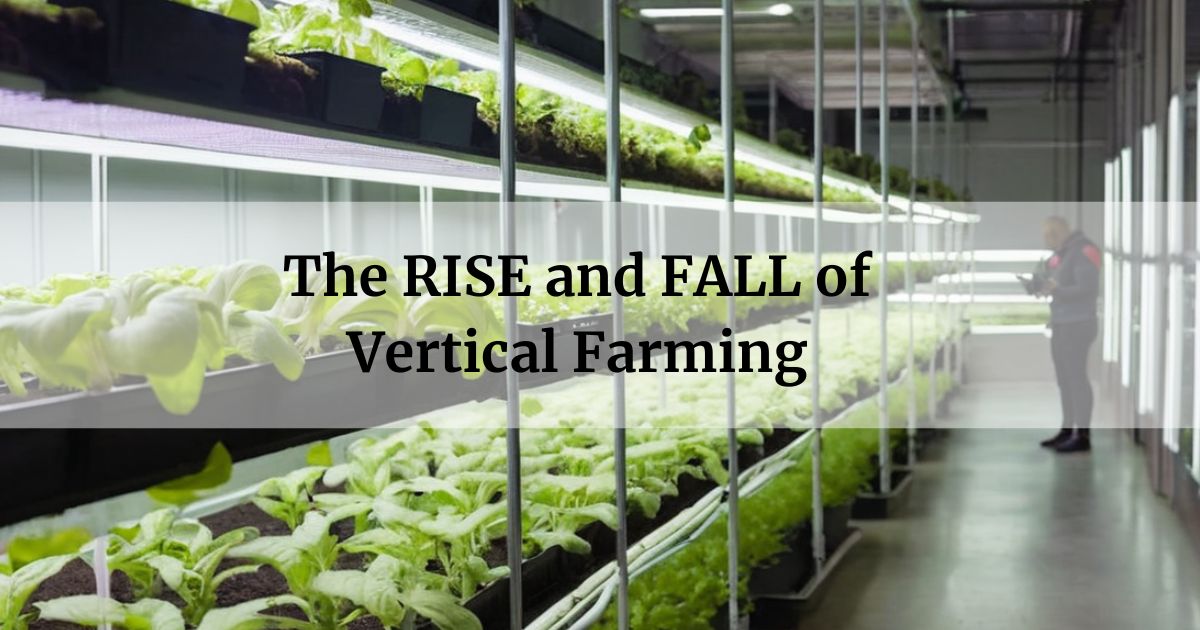
Vertical farming, once hailed as the revolutionary solution to global hunger and sustainable agriculture, is facing a crisis. What was once thought to be the future of food production is now marred by bankruptcies and failures. But what went wrong?
In this article
Understanding the Promise
One of the most enticing promises of vertical farming is the potential for enhanced crop yields. Traditional farming methods have their limitations, often constrained by the availability of arable land and the unpredictability of weather conditions. Vertical farming, on the other hand, offers a controlled and optimized environment for plant growth.
With precise control over factors like light, temperature, and nutrient levels, crops can reach their full potential. In some cases, vertical farming promised the ability to produce yields multiple times higher than traditional farming methods.
Conventional farming methods require vast amounts of water for irrigation, often leading to unsustainable water consumption. Vertical farming, however, presents a solution to this problem. Through the use of recirculating water systems and advanced irrigation techniques, vertical farms can drastically reduce water usage. Some estimates suggest that vertical farming can use up to 90% less water compared to traditional farming methods.
Vertical farming also offered a way to overcome unpredictable weather limitations by providing a controlled environment for year-round production. By utilizing artificial lighting, climate control systems, and advanced monitoring technologies, they could the perfect growing conditions regardless of the external weather.
Vertical farming, with its ability to grow crops in stacked layers, presented a way to maximise the use of space in a smaller area to grow crops. This opened up the possibility of growing food in densely populated urban areas, where traditional farming would be impractical or impossible. Rooftop gardens, abandoned buildings, and even underground structures can be transformed into thriving vertical farms.
In 2023, the US vertical farming market was estimated to be worth USD 3.21 billion. While the market share is substantial, it’s essential to recognize that vertical farming is poised for significant growth. By 2032, the global vertical farming market is projected to reach USD 40.45 billion, with a compound annual growth rate (CAGR) of 26.4% during the forecast period. North America, including the US, remains a key player in this transformative agricultural sector.
mordorintelligence.com
The Initial Excitement and Investments
In the early 2020s, vertical farming experienced a surge in investments, with billions of dollars poured into hundreds of startups worldwide. Ventures were backed by the allure of becoming the next unicorn in the agricultural sector. Companies like Infarm and Bowery Farming garnered significant attention, raising millions and achieving unicorn status.
Unveiling the Realities and Challenges
However, the initial excitement surrounding vertical farming has gradually waned as the industry has come face to face with some harsh realities:
Rising Operational Expenses: Despite the impressive yields that vertical farms have been able to achieve, they have been plagued by exorbitant operational costs. Labor expenses, capital investments in equipment, and the substantial energy consumption required for artificial lighting and climate control systems have all contributed significantly to these mounting expenses.
Limited Crop Variety: Although vertical farms have the potential for year-round production, their focus has primarily been on cultivating leafy greens such as lettuce and basil. The lack of diversity in crops raises concerns about the feasibility of meeting the diverse nutritional needs of consumers. The question arises: can vertical farming truly provide a wide range of produce?
Challenges in Competing on Price: One of the major hurdles faced by vertical farms is their struggle to compete with traditional farming methods in terms of pricing. The high production costs associated with vertical farming inevitably translate into higher prices for consumers. This, in turn, makes it increasingly difficult for vertical farms to gain a significant share of the market.
Technical Obstacles: Vertical farming relies heavily on advanced technology and skilled labor, which presents barriers to scalability and profitability. Additionally, the closed-loop systems employed by these farms make them vulnerable to risks such as pest infestations and disease outbreaks. These challenges further compound the difficulties faced by vertical farmers.
As the euphoria surrounding vertical farming dissipates, it becomes evident that the industry must address these issues in order to sustain its growth and viability. The future of vertical farming hinges on finding solutions to these challenges and ensuring that the benefits of this innovative approach to agriculture can be realized on a larger scale.
Lessons Learned
As vertical farming grapples with its challenges, there are valuable lessons to be learned:
- Focus on Innovation: The industry must prioritize innovation to address operational inefficiencies and reduce costs. Advancements in technology, automation, and energy-efficient systems can enhance productivity and sustainability.
- Diversification of Crops: Embracing a wider range of crops beyond leafy greens can broaden market appeal and meet consumer demand for variety and nutrition.
- Strategic Location Choices: Companies should consider locating vertical farms in regions with favorable conditions such as abundant renewable energy sources and supportive regulatory environments.
- Collaborative Efforts: Collaboration between researchers, entrepreneurs, and policymakers is essential to overcome challenges and drive sustainable growth in the vertical farming sector.
While the journey of vertical farming has been fraught with setbacks, it remains a promising avenue for sustainable agriculture. By addressing key challenges and embracing innovation, the industry can realize its potential and contribute to feeding a growing global population.







